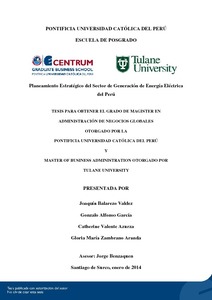| dc.contributor.advisor | Benzaquen de las Casas, Jorge Benny | |
| dc.contributor.author | Balarezo Valdez, Joaquín | es_ES |
| dc.contributor.author | García, Gonzalo Alfonso | es_ES |
| dc.contributor.author | Valente Azurza, Catherine | es_ES |
| dc.contributor.author | Zambrano Aranda, Gloria María | es_ES |
| dc.date.accessioned | 2017-02-14T15:47:12Z | |
| dc.date.available | 2017-02-14T15:47:12Z | |
| dc.date.created | 2014 | |
| dc.date.issued | 2017-02-14 | |
| dc.identifier.uri | http://hdl.handle.net/20.500.12404/7770 | |
| dc.description.abstract | Durante la década del sesenta la generación eléctrica peruana era suministrada por el
sector privado, las empresas de la época trabajaban mediante concesiones temporales y con
limitada capacidad de abastecimiento impidiendo que el servicio llegara a los lugares más
alejados del país. En 1972 se creó Electroperú como la primera empresa de generación
eléctrica de propiedad del Estado, y como resultado de la fuerte inversión en este rubro, se
incrementó de manera significativa la capacidad de generación con grandes proyectos. En
1992 entró en vigencia la Ley de Concesiones Eléctricas 25844 (la cual rige hasta la
actualidad), con la cual se implementan las primeras reformas que norman las actividades y
negocios del sector eléctrico, como la eliminación del monopolio que ejercía el Gobierno
sobre la totalidad de la actividad de generación y venta de energía, descomponiéndola en tres
pilares básicos: (a) generación, (b) transmisión, y (c) distribución.
La actividad o sector de generación de energía eléctrica en el Perú está creciendo en
paralelo con la economía peruana, pero se cree que en los próximos años será difícil cubrir la
creciente demanda si no se planifican y desarrollan más proyectos, sobre todo en las zonas
norte y sur del país. La mayoría de las centrales de generación están ubicadas en la zona
centro del país, y a 2013 concentran un 60% de la capacidad. El planeamiento estratégico
desarrollado en este trabajo plantea la importancia de incrementar la capacidad de generación
eléctrica en el país, así como descentralizarla y diversificar la matriz energética, que en la
actualidad es básicamente hidráulica y térmica. También se plantea disminuir la demanda no
atendida, incrementar el rendimiento financiero promedio de las principales empresas del
Sector así como disminuir las fallas fortuitas. Por último, se destaca la importancia de
mantener altos estándares de responsabilidad social así como respetar el medioambiente.
Finalmente, si bien el presente planeamiento estratégico se basa más en el mercado
interno, es decir, en asegurar el abastecimiento de la creciente demanda, se identificó una
oportunidad de exportar energía eléctrica a países vecinos, para lo cual el Sector debe trabajar
coordinadamente con el Estado para conseguir los convenios bilaterales y alianzas con
empresas de transmisión que permitan un adecuado canal de distribución | es_ES |
| dc.description.abstract | During the 1960’s, the Peruvian electric generation was in the hands of the private
sector; during these times companies worked by temporary concessions and limited supply
capacity, preventing the service to reach the most remote places of the country. In 1972,
Electroperú was formed as the first power generation company owned by the State. As a
result of strong investments by State in this area, the generation capacity significantly
increased through the implementation of large projects. In 1992, came into force the
Electrical Concessions Law 25844 (still effective today) from which the first reforms to
govern the electricity sector activities and businesses, such as the elimination of the
monopoly exercised by the government on the whole activity from generation to energy sales,
breaking it down into three basic pillars: (a) generation, (b) transmission, and (c) distribution.
The activity or sector of electricity generation in Peru is growing along side by side
with Peruvian economy, but it is believed that in the coming years will be difficult to meet
the growing demand if more projects are not plan and develop, especially in northern or
southern regions. Most power plants are located in the center of the country, and by 2013
concentrated 60 % of capacity. Strategic planning in this paper focuses on the importance of
increasing the power generation capacity in the country as well as decentralize and diversify
the energy matrix, which now is basically hydro and thermal. It also aimed to reduce unmet
demand, increase the average revenues of the top companies in the sector and reduce forced
outages or interruptions. Furthermore, it highlights the importance of maintaining high
standards of social responsibility and respect for the environment.
Finally, while the present strategic planning is based more on the domestic market to
ensure supply of the growing demand, an opportunity to export electricity to neighboring
countries, for which the sector must work hand in hand with the state identified to achieve
bilateral agreements and alliances with transmission companies to permit adequate
distribution channel | es_ES |
| dc.language.iso | spa | es_ES |
| dc.publisher | Pontificia Universidad Católica del Perú | es_ES |
| dc.rights | info:eu-repo/semantics/openAccess | es_ES |
| dc.rights.uri | http://creativecommons.org/licenses/by-nc-nd/2.5/pe/ | * |
| dc.subject | Empresas eléctricas -- Perú | es_ES |
| dc.title | Planeamiento estratégico del sector de generación de energía eléctrica del Perú | es_ES |
| dc.type | info:eu-repo/semantics/masterThesis | es_ES |
| thesis.degree.name | Maestro en Administración de Negocios Globales | es_ES |
| thesis.degree.level | Maestría | es_ES |
| thesis.degree.grantor | Pontificia Universidad Católica del Perú. CENTRUM | es_ES |
| thesis.degree.discipline | Administración de Negocios Globales | es_ES |
| renati.advisor.dni | 42800984 | |
| renati.advisor.orcid | https://orcid.org/0000-0001-8098-6401 | es_ES |
| renati.discipline | 413307 | es_ES |
| renati.level | https://purl.org/pe-repo/renati/level#maestro | es_ES |
| renati.type | https://purl.org/pe-repo/renati/type#tesis | es_ES |
| dc.publisher.country | PE | es_ES |
| dc.subject.ocde | https://purl.org/pe-repo/ocde/ford#5.02.04 | es_ES |






